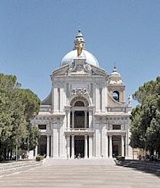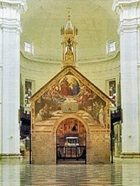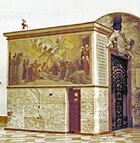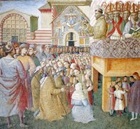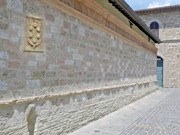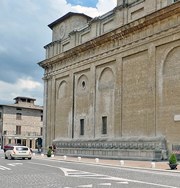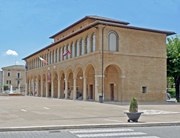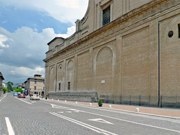This huge church protects two tiny chapels, both of which are closely associated with St Francis:
-
✴the
Cappella della Portiuncula, which was formally know as the Cappella di Santa Maria degli Angeli and which had been at the heart of the first Franciscan community; and
-
Earlier Situation
The situation around the Portiuncula before the present church was built can be seen in this fresco (1516) by
Tiberio d' Assisi in the
Cappella delle Rose, which depicts St Francis proclaiming the granting of the
Portiuncula Indulgence. Its relevance here lies in the fact that it shows Portiuncula as it was in 1516 and part of the
ad hoc assembly of other structures that surrounded it. In particular:
-
✴the chapel that had been built behind the Portiuncula was used by the friars from the adjacent convent used a for their own services; while
-
✴the chapel to the left was probably used for services for the benefit of pilgrims assembled in the open air. They would watch through the grill as the priest performed the Mass and listen to sermons from the pulpit to the right of this chapel.
The situation was not ideal, although the Medici family in particular had taken of number of steps to ease the difficulties of pilgrims and friars:
-
✴in 1450, Cosimo de' Medici provided for the building of an aqueduct to bring water to the convent;
-
✴in 1486, Lorenzo de' Medici paid for the renovation of this aqueduct; and
-
✴in 1526, Pope
Clement VII (Giuliano de' Medici) commissioned a small fountain, the
Fonte delle Tre Cannelle, the remains of which can still be seen, replete with the Medici arms, in the wall of the building opposite the left wall of the church.
New Church
The Council of Trent, which ended in 1563, gave a new impetus to celebrations such as the Festa del Perdono, and the number of pilgrims arriving at the Portiuncula seems to have increased dramatically. Pope Pius V therefore commissioned this huge church which was to be built over the venerated places “ad instar sacrae Lauretanae domus”: i.e. in the same way that the Basilica della Santa Casa (1469-1587) was being built over the Holy House of the Virgin at Loreto.
The Perugian architect Galeazzo Alessi received a payment for a model of the new church in 1568. Bishop Filippo Geri laid the foundation stone on 25th March 1569, at which point the papal architect Giacomo Barozzi da Vignola was asked for his advice on the design. Alessi received a second payment in 1570. There was however considerable opposition to the plans on the part of individuals who had built their own private chapels on the site. Construction did not begin until 1579, by which time Alessi was dead, but the contract with the masons specified that it should be built to his design.
Other delays followed:
-
✴further finance had to be raised in 1593;
-
✴the facade was built in 1597-1600;
-
✴construction of the semi-circular choir was started in 1622 after a seven-year debate about its design;
-
✴the old buildings in the crossing were demolished in ca. 1640 in order for the last pilaster that would support the cupola to be built;
-
✴Giacomo Giorgetti advised the friars on aspects of its construction in 1670-5. (They ceded him a burial site in the church in 1676, and he was buried there three years later.)
-
✴the octagonal drum and the dome above it were finished in 1667;
-
✴construction of the church was finally completed in 1679; and
-
✴one of the planned campanile was built in 1684, but the other (illustrated below at the end of the left wall) was never completed.
By the end of the 16th century, even before the new church was completed, some 100,000 pilgrims visited it each year. The Medici family continued to improve the facilities for pilgrims:
-
✴In 1610, they commissioned the much larger fountain on the left wall of the church, opposite that of Pope Clement VII. It is known as the
Fonte delle Ventisei Cannelle because of its 26 spouts, and also bears the Medici arms.
-
✴In 1615-20, they commissioned the palace in the Piazza della Portiuncula (now Piazza Garibaldi) to house the Capitano del Perdono, the official who supervised the pilgrims during the Festa del Perdono. (It now houses the
Museo Pericle Fazzini, which is devoted to the sculpture of
Pericle Fazzini).
Recent History
A earthquake in 1832 led to the collapse of the nave and part of the left aisle: the dome survived but was left with a wide crack. The church was restored in 1836-40, using stones from the ruined Monastero di San Vittorino (see Around Assisi). In 1909, Pope Pius X raised the church to a "patriarchal basilica and papal chapel", the high altar was rebuilt and a papal throne was added. The façade was rebuilt in 1928-30, to a design by Cesare Bazzani.
In 1990, the remains of the ancient pilgrim way from Santa Maria degli Angeli to Assisi were discovered during roadworks, and the path was relaid above using new bricks, each of which bears the name of a donor. The first part of the path, known as the “
Strada Mattonata” (brick road), runs along the left side of the church.


